
Los Molinos Dam
Encyclopedia
The Los Molinos Dam is a dam
over the course of the Los Molinos River in the center-west of the province
of Córdoba
, Argentina
, at 31°50′S 64°32′W, about 769 m above mean sea level
.
The dam gathers the flow of a 980 km² catchment basin
. Its wall is 60 m high and 240 m long. The reservoir has a surface area of 24.5 km² and a volume of 399 million m³; the maximum depth of the water is 57 m.
The dam was built between 1948 and 1953, and its primary goals are the regulation of the flow of the river and the production of hydroelectricity
. The Los Molinos I power plant generates 148 MW for the Center Region of the Argentine Interconnection System (see Electric power in Argentina).
The reservoir is bordered by Provincial Route 5. It is employed for fishing
(silverside
), swimming, water skiing
and sailing
.
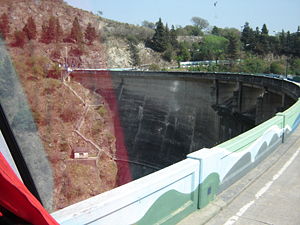
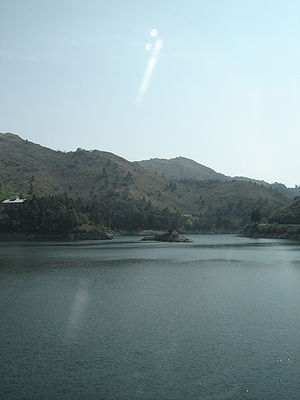
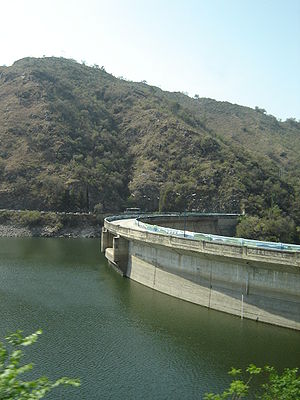
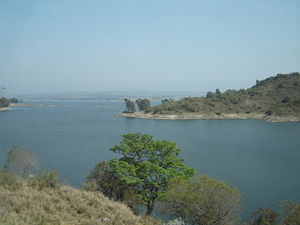
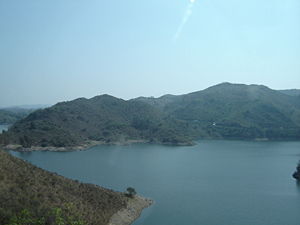

Dam
A dam is a barrier that impounds water or underground streams. Dams generally serve the primary purpose of retaining water, while other structures such as floodgates or levees are used to manage or prevent water flow into specific land regions. Hydropower and pumped-storage hydroelectricity are...
over the course of the Los Molinos River in the center-west of the province
Provinces of Argentina
Argentina is subdivided into twenty-three provinces and one autonomous city...
of Córdoba
Córdoba Province (Argentina)
Córdoba is a province of Argentina, located in the center of the country. Neighboring provinces are : Santiago del Estero, Santa Fe, Buenos Aires, La Pampa, San Luis, La Rioja and Catamarca...
, Argentina
Argentina
Argentina , officially the Argentine Republic , is the second largest country in South America by land area, after Brazil. It is constituted as a federation of 23 provinces and an autonomous city, Buenos Aires...
, at 31°50′S 64°32′W, about 769 m above mean sea level
Above mean sea level
The term above mean sea level refers to the elevation or altitude of any object, relative to the average sea level datum. AMSL is used extensively in radio by engineers to determine the coverage area a station will be able to reach...
.
The dam gathers the flow of a 980 km² catchment basin
Drainage basin
A drainage basin is an extent or an area of land where surface water from rain and melting snow or ice converges to a single point, usually the exit of the basin, where the waters join another waterbody, such as a river, lake, reservoir, estuary, wetland, sea, or ocean...
. Its wall is 60 m high and 240 m long. The reservoir has a surface area of 24.5 km² and a volume of 399 million m³; the maximum depth of the water is 57 m.
The dam was built between 1948 and 1953, and its primary goals are the regulation of the flow of the river and the production of hydroelectricity
Hydroelectricity
Hydroelectricity is the term referring to electricity generated by hydropower; the production of electrical power through the use of the gravitational force of falling or flowing water. It is the most widely used form of renewable energy...
. The Los Molinos I power plant generates 148 MW for the Center Region of the Argentine Interconnection System (see Electric power in Argentina).
The reservoir is bordered by Provincial Route 5. It is employed for fishing
Fishing
Fishing is the activity of trying to catch wild fish. Fish are normally caught in the wild. Techniques for catching fish include hand gathering, spearing, netting, angling and trapping....
(silverside
Silverside (fish)
The Old World silversides are a family, Atherinidae, of fish in the order Atheriniformes. They occur worldwide in tropical and temperate waters...
), swimming, water skiing
Water skiing
thumb|right|A slalom skier making a turn on a slalom waterski.Waterskiing is a sport where an individual is pulled behind a boat or a cable ski installation on a body of water, skimming the surface.-History:...
and sailing
Sailing
Sailing is the propulsion of a vehicle and the control of its movement with large foils called sails. By changing the rigging, rudder, and sometimes the keel or centre board, a sailor manages the force of the wind on the sails in order to move the boat relative to its surrounding medium and...
.







